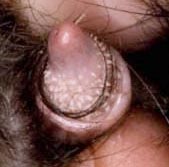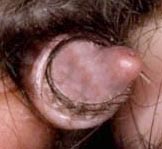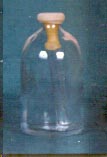Tom
 767-768 767-768
Normal Breeding
- Puberty in the male (tom) is reached at
approximately nine months or 3.5 kg.
- Penile spines
- Present with testosterone
- Absent without.
 
This photo shows what a tom's penis looks like
with spines (left) vs. without (right).
- Breeding is most likely to occur in the male's home
breeding territory during the nocturnal period.
- The copulatory act of the male and queen have been
described in detail.
- Mounting the queen and firmly grasping the neck
with his teeth, the male positions himself for insertion of the
penis into the vagina.
- After successful breeding, the queen emits a
scream and strikes at the male while he rapidly retreats.
- During the queen's period of sexual receptivity,
the tom may breed the queen eight times in 20 minutes and then
repeatedly during a day.
- In natural breeding situations, a tom may
breed until he is either 'satisfied' or physically exhausted.
- Multiple matings over a 24 hour period probably enhance the chance
that the queen will ovulate.
- Despite the fact that repeated matings occur over a
short time period, only one report shows the effect of multiple
semen collections on tomcat semen characteristics.
- Most published
data available on tomcat semen characteristics reports only single
collections taken daily, every other day, or weekly.
- In the report
that collected multiple ejaculates, electroejaculation was used on
anesthetized toms to collect four consecutive semen samples at
weekly intervals.
- There were more sperm cells in the second
ejaculate than in the first, third or fourth ejaculates.
- Electroejaculation, however, has been shown to produce larger
volumes of semen with fewer total cells than collections using an
artificial vagina.
- Using current information, it is therefore
commonly advised to breed a tom in one of two ways:
- 3 times a week
(every other day) or
- once daily for a short time.
- Multiple breeding
each day for 1 to 3 days, however, are preferred for maximum
fertility.
- Despite the preference for multiple matings, no
convincing research exists which suggests the effect of continual
repeated mating on tomcat semen characteristics.
- Current information
does not reveal whether the multiple matings by the tom are
primarily for deposition of more semen, to enhance successful
induction of ovulation or a combination of both.
Breeding Soundness Examination
- Collecting an ejaculate from the tom can be
performed using an artificial vagina or an electroejaculator.
- An artificial vagina has been described by Sojka
and consists of a test tube on a rubber pipette bulb inserted into
the mouth of a small plastic bottle.


- A daily training period of 2-3
weeks is needed before the tom will become accustomed to an
artificial vagina.
- Since 30-40% of toms cannot be trained to use an
artificial vagina, it is not a procedure commonly performed in
practice.
- A normal ejaculate should contain 21.5 - 117.0 X 106
cells in 0.03 -0.09 ml.
-
Motility should be approximately 40 - 80%
and
-
50 - 70% of the cells should be morphologically normal.
- An electroejaculator can be used on the
anesthetized tom to collect an ejaculate.
- A special probe and
instrumentation are needed to electroejaculate the tom.
- Technique
-
•Medetomadine
–130-140
ug/kg IM
-
3 Fr catheter inserted
9 cm
-
Urethral sperm
-
Lower volume
-
Same
characteristics as EE
- A semen
sample collected by electroejaculation should have a volume of 0.11
- 0.49 ml and contain 11.1 - 65.9 X 106
cells.
-
Motility should be approximately 50 - 70% and
-
40 - 80% of the
cells should be morphologically normal.
- A more practical method to prove the existence of
spermatogenesis is the recovery of sperm cells from the vagina
immediately after natural mating.
- Sperm cells can be collected from
the vagina using a cotton swab or flushed out using a pipette and
observed under a microscope.
- An alternative method to document sperm
production is by recovering sperm cells from the bladder of the tom
after mating.
- Retrograde flow of the tom's ejaculate into the
bladder normally occurs when ejaculates are induced by natural
mating, an artificial vagina or an electroejaculator.
- In one report,
9 - 45 X 106
sperm cells were recovered from the bladder after the tom ejaculated
into an artificial vagina.
-
Retrograde flow into the bladder was
calculated to be 14 - 90% of the total ejaculate.
-
Clinically, the
urine in the bladder collected by cystocentesis immediately after
natural mating can be conservatively assumed to contain about 20% of
the total number of the cells in the ejaculate.
-
Counting the total
number of cells in the bladder post coitus and multiplying by five
can be used to give an estimate of the total number of cells in the
ejaculate.
Artificial Insemination
- Artificial insemination can be performed in the
queen using semen collected with an electroejaculator or an
artificial vagina.
- A tomcat catheter can be used to inseminate the
ejaculate into the queen.
- Following AI, the queen needs the
appropriate stimulus to induce ovulation.
- Results of artificial
insemination using fresh semen have yielded pregnancy rates of 75%
and 10% using frozen semen.
- With a tom that has very poor semen or with a
chronically infertile queen, surgical insemination via a laparotomy
and deposition of the semen directly into the uterine lumen using a
needle may improve chances of conception.
Male Infertility
- Infertility in the tom can be broken down into
three categories:
- 1) the failure to show sexual interest
- 2) the
failure to breed successfully and
- 3) the failure to impregnate
queens after successful breeding.
- Failure to show sexual interest can arise when the
tom is placed in strange surroundings to breed.
- Instead of being
able to focus on breeding, he spends his time establishing a new
territory in these unfamiliar surroundings.
- To avoid this problem
queens should be placed in the tom's territory for breeding.
- Because cats are nocturnal breeders, it is also
best to allow the tom and queen to breed at night.
- The tom may be a novice breeder and may need the
assistance of an experienced queen to minimize the anxiety of the
first breeding.
- Some toms have poor libidos and are not interested
in breeding.
- This condition may be a primary problem of the tom or
result from a queen's dominance over the tom in the social order.
- No
hormonal therapy is recommended for toms that fail to show sexual
interest.
- If testosterone concentrations are normal in the tom (1000
pg/ml) testosterone therapy will not enhance libido but will
probably decrease sperm production.
- Artificial insemination may be
considered when the tom refuses to breed or the queen refuses to
accept the tom.
- When a tom shows good libido but fails to breed
successfully, dental and penile problems should be considered.
Because the neck bite at breeding is essential to successful
breeding, toms with dental problems will sometimes not be able to
breed effectively.
- Hair rings around the penis can also cause
discomfort which will impede successful copulation.
- Size
differential between tom and queen can also prevent successful
mating.
- The failure to impregnate queens after successful matings
which induce ovulation should alert the clinician to the possibility
of congenital or acquired azoospermia which can be detected by
performing a breeding soundness examination.
- Cryptorchid toms should not be used for breeding
because of the hereditary potential of the problem.
|
 Male
Index
Male
Index Male
Index
Male
Index